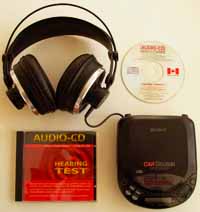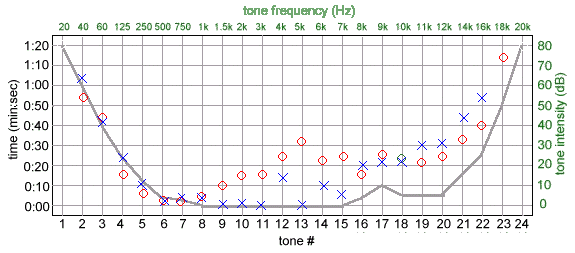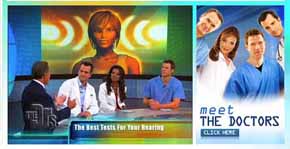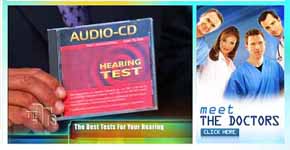|
|
Featured on the TV program "The Doctors"
|
|
|||||||||||||||||||||||
|
THEN YOU ARE IN DANGER OF SUFFERING A HEARING LOSS |
|
Why? Because each of these activities subjects you to factors that can
damage your hearing. These include excessive sounds, certain chemicals and
some medications.
Why should you be concerned? Because good hearing is important in everyday
life, at work and at home. Good hearing keeps you safe when crossing the
street or hiking in the woods. It allows you to communicate effectively
with family, friends and colleagues. And it brings joy -- the sound of
children laughing, music, nature. Therefore, it makes good sense to protect
it. In some cases, you can use ear protection. But, since this is not always
possible, or often regarded as unnecessary, there is another way to make
sure your hearing stays in top shape. Introducing
a compact disc that offers an easy and inexpensive method for detecting hearing loss early, allowing you to take preventive and corrective action. |
How is AUDIO-CD used for hearing testing?

AUDIO-CD provides anyone -- for the first time ever -- with an easy-to-use,
self-administered hearing test right in the comfort of your home. The test
is performed over a range of 24 frequencies -- from 20 Hz, the lowest
frequency humans can hear, to 20,000 Hz, the highest frequency humans can
hear. All you need to perform the test is a CD player and a set of
headphones or earphones.
The Special Calibration Tone included on the AUDIO-CD
allows for volume calibration with +/- 3 dB accuracy. If higher accuracy
or objective calibration is required this can be accomplished
with our inexpensive
semi-professional coupler DR1-R
and a Radio Shack Sound Level Meter.
The graph below shows a sample chart of hearing test results. This chart
is referred to as an audiogram. The "x"s
indicate the left ear results, the "o"s indicate the right ear results.
The grey line indicates the "ideal" results, which are the same for both ears.

|
|
How are hearing test results interpreted?
| ||||||||
|
It's easy!
The time (measured in seconds) that passes before the test tone
is heard represents the intensity (measured in dB) of the tone at the point
the tone is heard. Therefore, if it takes 10 seconds for the tone to be
heard, the intensity of the tone at this point is 10 dB. This intensity is
referred to as the "hearing threshold" for the tone. The purpose of one's
hearing test is to find hearing thresholds for all of the test tones, chart
them, and then compare the charted results against the "ideal" hearing
thresholds.
An upward deviation of more than 10 dB from an "ideal" threshold indicates
a hearing loss. The severity of a hearing loss can be determined based on
the provided table. Any concerns with the hearing test results should be
brought to the attention of an audiologist or acoustician.
|
|
|||||||
|
How can hearing testing with AUDIO-CD help prevent hearing loss?
Permanent hearing loss, often referred to as Permanent Threshold Shift (PTS),
can be caused by exposure to excessive sounds,
certain chemicals and some
medications. The sad fact is that, once damaged,
hearing never gets better. Continued exposure to factors that cause hearing
loss will make matters worse. Degradation is gradual. There is usually no
pain or other alarming symptoms. Often, hearing loss goes unnoticed until
it starts interfering with verbal communication. At this point, damage to
hearing is already significant.
A regular check of hearing ability (once every 6 months, for example), is the only
truly effective method for identifying the early signs of hearing loss.
This allows you to take preventive or corrective steps, while damage to
hearing is still in the early stages.
The first audiogram should be used as a reference point and all consecutive
audiograms should be compared against it. The series of audiograms will
help to uncover any downward trends in one's hearing ability and identify
the factors causing hearing loss.
AUDIO-CD is also ideal for determining temporary hearing loss, often referred to
as Temporary Threshold Shift (TTS). This type of
hearing loss usually disappears within 16 to 18 hours after prolonged
exposure to moderate levels of sounds, chemicals or medications. A series
of episodes of temporary hearing loss, with insufficient time for recovery
between exposure, will eventually cause permanent hearing loss. Therefore,
it is important to understand their causes. AUDIO-CD is often the only
possible or practical solution for detecting temporary hearing loss. It
allows you to test hearing ability right after exposure to sources of damage.
To determine the presence, and to assess the magnitude, of temporary
hearing loss, the test results should be compared against the reference
audiogram.
|
|
Who benefits the most from using AUDIO-CD for hearing testing?
AUDIO-CD is of benefit to both general
public and health care professionals. In particular it is of great use to
|
|
What do others think about AUDIO-CD?
The following testimonial is typical of those
who have used AUDIO-CD:
" The quality of the stimuli (i.e. the test tone) is very good and the
procedure to find
HTs (i.e. Hearing Thresholds) is very clever (my colleague - Dr. Brad McPherson - used the
word 'ingenious'). Clearly, given the limitations of testing someone's
hearing on his/her own hi-fi at home, it would have been very difficult
to find an easier procedure to use." Dr.Valter Ciocca, University
of Hong Kong, Hong Kong |
|
Terms of Use |
Return Policy |
Privacy Policy
![]()
Copyright (©) 1989-2022 by Digital Recordings. All Rights Reserved.
No part of the information provided on this www page may be
reproduced for any purpose,
in any form, without prior written approval.
This site uses frames. To enjoy them your screen's resolution should be
at least 800 x 600, preferably 1024 x 768. To invoke frames click
here.



![[ hearing testing with AUDIO-CD ]](http://www.digital-recordings.com/images/aud_logo.gif)
![[ DR1-R coupler ]](http://www.digital-recordings.com/images/dr1-r.gif)